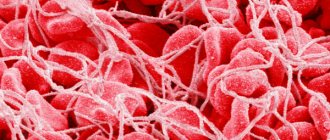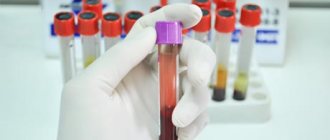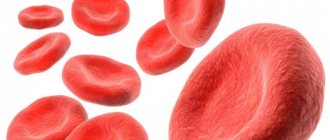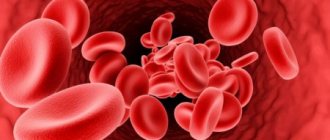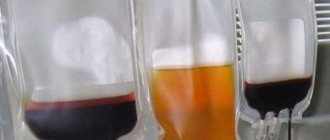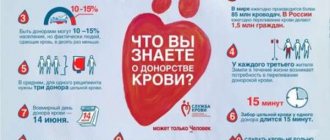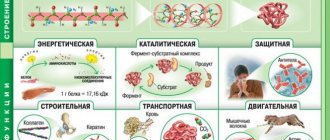Protein fractions in blood
The main biological fluid of the body, blood, is divided into two parts during a biochemical study:
- formed elements or blood cells (erythrocytes, leukocytes, platelets);
- plasma or liquid part in which proteins, compounds with proteins (enzymes, hormones), minerals, nutrients, etc. are concentrated.
There are up to 80 g of proteins per 1000 ml of plasma. More than half is albumin, the remaining part is fibrinogen (up to 0.4%) and globulins (alpha-1 - up to 5%, alpha-2 - up to 13%, beta - up to 15%, gamma - up to 22%), etc. In total, the blood contains 150 types of proteins that take part in all biochemical processes of the body.
When proteins are supplied, they are broken down into amino acids (13 essential and 9 essential), from which the body synthesizes its own proteins and protein compounds. When infectious agents are introduced into the body, the hepatic synthesis of acute phase proteins is activated, the main of which are considered to be C-reactive (C-reactive, CRP) and amyloid A-protein.
Protein fractions
Protein compounds in the blood, depending on their composition, are divided into simple and complex. An example of the first fraction is albumin, and the second is lipoproteins, metalloproteins and glycoproteins. Let's look at the main ones:
- Albumins are individual proteins in the blood plasma, the synthesis of which occurs in the liver. These elements are being updated rapidly. In just twenty-four hours, about 15 grams of albumin are synthesized and degraded. If we consider the functional purpose of this faction, then its tasks are different. First of all, it is supporting oncotic pressure, creating a reserve of amino acids, transporting nutrients to their destination (organs and tissues), especially those that do not dissolve in water.
- Alpha-1-globulins are physiological useful proteins in blood plasma, characterized by hydrophilicity and low molecular weight. Once kidney failure occurs, they are excreted in the urine without causing any effect on oncotic pressure. Blood plasma proteins from the globulin fraction deliver lipids to their destination, help blood clot normally, including inhibiting certain enzymes that adversely affect the body,
Functions of proteins
Proteins are the building blocks for cells and perform a number of essential life-support functions for the body:
- transporting oxygen from the lungs to the tissues of the body, moving carbon dioxide (carbon dioxide) in the opposite direction;
- preservation of immunity;
- formation of oxygen reserve and amino acid reserve;
- guarantee of molecular compression to maintain a stable COP (colloid osmotic pressure, which regulates water metabolism in the body);
- protection of red blood cells (erythrocytes) from premature destruction;
- neutralization of low-density lipoproteins (“bad cholesterol”) and protection of vascular walls from damage;
- delivery of drugs, adrenal and thyroid hormones, organic compounds, nutrients and acids to organs through the bloodstream.
Proteins are involved in maintaining blood clotting and building muscle tissue. The correct amount of protein fractions in the blood is an indicator of normal homeostasis (constancy of the internal environment of the body).
Conclusion
Proteins play an important role in the human body; without their participation in many processes, not a single organ would be able to function. Since there are a huge number of protein substances, they are separated into fractions according to their functions and physicochemical composition. Each fraction is assigned certain tasks, and any deviation from the quantitative norm of such elements indicates the development of pathologies. The main thing is to undergo a medical examination on time and consult a doctor if you feel unwell. Only timely detection of abnormalities will allow the disease to be successfully treated.
Loading…
Laboratory research of protein fractions
Determination of protein concentration is carried out as part of a biochemical blood test. The study is prescribed for diagnostic and preventive purposes, before hospitalization and to monitor ongoing therapy. A separate check of plasma protein levels is indicated for diagnosed:
- liver and kidney diseases;
- oncopathologies;
- immunodeficiencies and autoimmune pathologies;
- anemia (of various origins);
- endocrine diseases (metabolic failure, diabetes mellitus);
- malabsorption (lack of absorption of nutrients by the intestines).
A pregnant woman's blood counts are monitored every trimester. If necessary, the frequency of studies can be increased.
Reference! In laboratory microscopy, protein fractions are measured in g/l.
Blood is donated for biochemistry on the direction of the attending physician. Preliminary preparation for the procedure includes avoiding alcohol and animal fats 2 days before the test, fasting for 10-12 hours (before donating blood), limiting physical activity on the eve of the procedure. Incorrect preparation may result in biased results.
Normal values
By gender, the amount of proteins in blood plasma differs slightly. For men of fertile age, the norm for total protein is from 76 to 85 g/l, for women – from 75 to 83 g/l. As the body ages, there is less protein in the blood. Taking into account age-related changes, in older people (60+) a level of 61-80 g/ is considered normal.
A slight decrease in proteins is allowed during pregnancy, which is associated with additional functional responsibilities of the body. During the perinatal period, proteins take part in preparing the uterus for delivery, form the protein reserve of the mammary glands, and protect the placenta.
Reference protein values for a woman expecting a baby
| Total (in g/l) | Fractions (percentage) | |
| albumen | globulins | |
| 65-85 | 55-65 | 29-45 |
A critical decrease in plasma proteins during pregnancy is considered to be 55 g/l. In childhood, protein levels are variable. In a newborn baby, the normal amount is from 46 to 69 g/l. At the age of six months, the upper limit rises to 76 g/l. A child’s total protein reaches stable values by the age of 16.
Norm for children by age (in g/l)
| 6 months - 1 year | 1-3 years | 3-16 years |
| 51-73 | 56-75 | 60-80 |
From 16 to 22 years of age, indicators gradually increase to the adult norm. The obtained analysis results are assessed primarily by albumin, total protein and CRP. Before puberty (14 years), C-reactive protein is normally absent. In adult men and women, a minimal presence is allowed (up to 0.5 mg/l).
Composition and objectives of non-protein compounds in plasma
Plasma contains:
- Organic compounds based on nitrogen. Representatives: uric acid, bilirubin, creatine. An increase in the amount of nitrogen signals the development of azotomy. This condition occurs due to problems with the excretion of metabolic products in the urine or due to the active destruction of protein and the entry of large amounts of nitrogenous substances into the body. The latter case is typical for diabetes, fasting, and burns.
- Organic compounds that do not contain nitrogen. This includes cholesterol, glucose, lactic acid. Lipids also keep them company. All these components must be monitored, as they are necessary to maintain full functioning.
- Inorganic substances (Ca, Mg). Na and Cl ions are responsible for maintaining a constant pH of the blood. They also monitor osmotic pressure. Ca ions take part in muscle contraction and stimulate the sensitivity of nerve cells.
Blood plasma composition
Albumen
Albumin in plasma blood is the main component (more than 50%). It has a small molecular weight. The place of formation of this protein is the liver.
Purpose of albumin:
- Transports fatty acids, bilirubin, drugs, hormones.
- Takes part in metabolism and protein formation.
- Reserves amino acids.
- Forms oncotic pressure.
Doctors judge the condition of the liver by the amount of albumin. If the albumin content in plasma is reduced, this indicates the development of pathology. Low levels of this plasma protein in children increase the risk of developing jaundice.
Globulins
Globulins are represented by large molecular compounds. They are produced by the liver, spleen, and thymus.
There are several types of globulins:
- α – globulins. They interact with thyroxine and bilirubin, binding them. Catalyze the formation of proteins. Responsible for transporting hormones, vitamins, lipids.
- β – globulins. These proteins bind vitamins, Fe, and cholesterol. They transport Fe and Zn cations, steroid hormones, sterols, and phospholipids.
- γ – globulins. Antibodies or immunoglobulins bind histamine and take part in protective immune reactions. They are produced by the liver, lymph tissue, bone marrow and spleen.
There are 5 classes of γ-globulins:
- IgG (about 80% of all antibodies). It is characterized by high avidity (antibody to antigen ratio). Can penetrate the placental barrier.
- IgM is the first immunoglobulin that is formed in the unborn baby. The protein has high avidity. It is the first to be detected in the blood after vaccination.
- IgA.
- IgD.
- IgE.
Fibrinogen is a soluble plasma protein. It is synthesized by the liver. Under the influence of thrombin, the protein is converted into fibrin, an insoluble form of fibrinogen. Thanks to fibrin, a blood clot forms in places where the integrity of the vessels has been compromised.
Other proteins and functions
Minor fractions of plasma proteins after globulins and albumins:
- Prothrombin,
- Transferrin,
- immune proteins,
- C-reactive protein,
- Thyroxine binding globulin,
- Haptoglobin.
The tasks of these and other plasma proteins boil down to:
- Maintaining homeostasis and aggregative state of blood,
- Controlling immune reactions
- Transport of nutrients
- Activation of the blood clotting process.
Exceeding normal values
High protein content is divided into two types:
- absolute hyperproteinemia - deviation of protein values due to a failure in the rate of protein metabolism and an increase in the amount of globulins, without changing the total blood volume;
- relative hyperproteinemia - an increase in protein levels due to an imbalance in the ratio of water in the plasma and formed elements (thickening of the biofluid).
Displacements of an absolute nature mean chronic destructive processes within the body. Relative hyperproteinemia in most cases is associated with dehydration (dehydration) and blood loss.
Physiological causes of deviations
A slight increase in the concentration of protein fractions (without changes in CRP) can occur under the influence of physiological factors:
- intense sports training;
- gastronomic preferences for protein foods;
- incorrect therapy with hormone-containing drugs;
- long-term immobilization;
- prolonged stay in a warm, stuffy room or in the sun.
An increase in C-reactive protein levels in adults, as well as its presence in the blood of children, always has a pathological basis (acute conditions or chronic diseases).
Diseases and conditions affecting blood protein levels
Possible reasons for the absolute increase in indicators:
What is albumin in a biochemical blood test?
- oncohematology and cancerous lesions of the bone marrow - Hodgkin's disease (lymphogranulomatosis), leukemia, Waldenström's macroglobulinemia;
- granulomas are nodular formations of infectious, inflammatory, necrotic or sclerotic origin. Occurs due to blood poisoning, infection with tuberculosis, syphilis, leprosy, development of sarcoidosis;
- autoimmune diseases - granulomatosis with polyangiitis (Wegener's granulomatosis), systemic lupus erythematosus, joint damage (rheumatoid arthritis), Crohn's disease, etc.;
- parasitic infestations (schistosomiasis).
Total protein in the blood is constantly increased during chronic inflammatory and necrotic processes (cirrhosis, pancreatic necrosis, gangrene, etc.). Relative hyperproteinemia occurs in acute conditions:
- acute stage of intestinal infections caused by pathogenic microorganisms (salmonella, vibrio cholerae, shigella, rotaviruses);
- severe intoxication (drugs, alcohol, etc.);
- burn lesions of the epidermis (skin) and deeper tissues;
- disruption of the movement of food through the digestive tract (intestinal obstruction);
- heavy bleeding (post-traumatic, post-operative, etc.);
- mechanical head injuries (traumatic brain injuries) with damage to the hypothalamus region;
- hyperhidrosis (excessive sweating), accompanied by chronic metabolic disorders.
Incorrect treatment with hormone-containing drugs can increase protein levels.
C-reactive protein
Reactive protein is the most sensitive marker of infectious and inflammatory processes, as a homeostatic response of the body to infection. Its concentration directly depends on the extent of the lesion, severity and stage of the disease. The content of CRP in the blood increases rapidly in the first 5-8 hours after infection or injury.
Values can increase 50-100 times. For diagnosing diseases, the CRP indicator in a biochemical blood test is as important an indicator as ESR (erythrocyte sedimentation rate) in a general clinical blood test.
If acute phase proteins are detected in the blood, it means that in the body:
- an acute infection develops (infection with bacteria, viruses, fungi, protozoa and worms);
- there is a relapse of a chronic disease (pyelonephritis, cystitis, cholecystitis), a complication of diabetes mellitus – ketoacidosis crisis;
- there is tissue damage with the formation of suppuration (burns, lacerations, abscesses, frostbite);
- necrotic processes progress (myocardial infarction, cirrhosis, gangrenous lesions and trophic ulcers);
- Gynecological diseases in women have worsened (endometriosis, endometritis).
A state of shock can increase the level of reactive protein. In adults, the cause is often vascular pathologies (angiopathies) and atherosclerosis.
Approximate indicators of DRR for violations
| Up to 30 mg/l | 40 – 100 mg/l | More than 100 mg/l |
| Hepatitis, herpes, chicken pox, influenza, sore throat and other viral infections, oncological tumors, collagenosis and vasculitis | Bacterial infections, appendicitis, peritonitis, heart attack | Sepsis, burn lesions over 50% of the body |
Total protein in whey
This is a measurement of the concentration of total protein (albumin + globulins) in the liquid part of the blood, the results of which characterize the metabolism of proteins in the body.
Synonyms Russian
Total protein, total serum protein.
English synonyms
Total Protein, Serum Total Protein, Total Serum Protein, TProt, TR.
Research method
Colorimetric photometric method.
Units
G/L (grams per liter).
What biomaterial can be used for research?
Venous, capillary blood.
How to properly prepare for research?
- Do not eat for 12 hours before the test.
- Avoid physical and emotional stress 30 minutes before the test.
- Do not smoke for 30 minutes before the test.
General information about the study
The total protein content in blood serum reflects the state of protein metabolism.
Proteins predominate in the solid residue of blood serum (the liquid part that does not contain cellular elements). They serve as the main building material for all cells and tissues of the body. Enzymes, many hormones, antibodies and blood clotting factors are built from proteins. In addition, they function as carriers of hormones, vitamins, minerals, fat-like substances and other metabolic components in the blood, and also ensure their transport into cells. The amount of proteins in the serum determines the osmotic pressure of the blood, which maintains a balance between the water content in the body tissues and inside the vascular bed. It determines the ability of water to be retained in the circulating blood and maintain tissue elasticity. Proteins are also responsible for ensuring proper acid-base balance (pH). Finally, it is a source of energy during malnutrition or starvation.
Serum proteins are divided into two classes: albumins and globulins. Albumin is synthesized in the liver from food. Their amount in the plasma affects the level of osmotic pressure, which holds fluid inside the blood vessels. Globulins perform an immune function (antibodies), ensure normal blood clotting (fibrinogen), and are also represented by enzymes, hormones and carrier proteins of various biochemical compounds.
A deviation in the level of total blood protein from the norm can be caused by a number of physiological conditions (not of a pathological nature) or be a symptom of various diseases. It is customary to distinguish between a relative deviation (associated with changes in the water content in the circulating blood) and an absolute deviation (caused by changes in the metabolism - the rate of synthesis / breakdown - of serum proteins).
- Physiological absolute hypoproteinemia can occur during prolonged bed rest, in women during pregnancy (especially in the last third) and breastfeeding, in children at an early age, that is, in conditions of insufficient protein intake from food or an increased need for it. In these cases, the total protein level in the blood decreases.
- The development of physiological relative hypoproteinemia (decrease in the level of total protein in the blood) is associated with excess fluid intake (increased water load).
- Relative hyperproteinemia (increased levels of total protein in the blood) can be caused by excess water loss, such as during profuse sweating.
- Relative pathological (associated with any disease) hyperproteinemia is caused by significant loss of fluid and blood thickening (with profuse vomiting, diarrhea or chronic nephritis).
- Pathological relative hypoproteinemia is observed in the opposite cases - with excessive fluid retention in the circulating blood (impaired kidney function, deterioration of heart function, some hormonal disorders, etc.).
- An absolute increase in total blood protein can occur in acute and chronic infectious diseases due to increased production of immune globulins, in some rare health disorders characterized by intense synthesis of abnormal proteins (paraproteins), in liver diseases, etc.
Absolute hypoproteinemia is of greatest clinical importance. An absolute decrease in the concentration of total protein in the blood most often occurs due to a decrease in the amount of albumin. A normal level of albumin in the blood is an indicator of good health and proper metabolism, and conversely, a low level indicates low vitality of the body. At the same time, the loss/destruction/insufficient synthesis of albumin is a sign and indicator of the severity of some diseases. Thus, an analysis of total blood protein makes it possible to identify a significant decrease in the vitality of the body due to any important health reasons or to take the first step in diagnosing a disease associated with a disorder of protein metabolism.
Depletion of albumin reserves in the blood can occur due to malnutrition, diseases of the gastrointestinal tract and difficulties in digesting food, chronic intoxication.
Diseases associated with a decrease in the amount of blood albumin include some disorders in the liver (decreased protein synthesis in it), kidneys (loss of albumin in the urine as a result of a violation of the blood filtration mechanism in the kidneys), certain endocrine disorders (disturbances in the hormonal regulation of protein metabolism) .
What is the research used for?
- As part of the first stage of a comprehensive examination in the process of diagnosing various health disorders.
- To identify and assess the severity of nutritional disorders (in case of intoxication, malnutrition, diseases of the gastrointestinal tract).
- For the purpose of diagnosing various diseases associated with protein metabolism disorders and to evaluate the effectiveness of their treatment.
- To monitor physiological functions during long-term clinical observations.
- To assess the functional reserves of the body in connection with the prognosis for the current disease or upcoming treatment procedures (drug therapy, surgery).
When is the study scheduled?
- During the initial diagnosis of any disease.
- For symptoms of exhaustion.
- If you suspect a disease associated with any disorders of protein metabolism.
- When assessing the state of metabolism or the thyroid gland.
- When examining liver or kidney function.
- With long-term clinical monitoring of the treatment of diseases associated with protein metabolism disorders.
- When surgery is being considered.
- During a preventive examination.
What do the results mean?
Reference values (normal total protein in the blood)
| Age | Reference values |
| 0 - 7 months | 44 – 76 g/l |
| 7 - 12 months | 51 - 73 g/l |
| 1 – 3 years | 56 - 75 g/l |
| 3 – 18 years | 60 - 80 g/l |
| > 18 years old | 64 – 83 g/l |
The results of the analysis of total protein in the blood serum allow us to assess the state of health, nutrition and the function of internal organs based on the effectiveness of their work in maintaining normal protein metabolism. If a deviation from the norm is detected, further examination is required to clarify its cause.
Reasons for increased levels of total protein in the blood
- Acute and chronic infection (including tuberculosis),
- dysfunction of the adrenal cortex,
- autoimmune diseases (rheumatoid arthritis, systemic lupus erythematosus, scleroderma),
- allergic conditions,
- some rare systemic diseases,
- loss of fluid (diabetic acidosis, chronic diarrhea, etc.),
- respiratory failure,
- destruction of red blood cells,
- active chronic hepatitis,
- some rare blood diseases.
Reasons for decreased levels of total protein in the blood
- Fluid retention due to impaired renal function or weakened heart function,
- insufficient intake of protein into the body or impaired absorption of food in the gastrointestinal tract (due to fasting, malnutrition, narrowing of the esophagus, inflammatory bowel diseases),
- decreased protein synthesis in the liver (due to hepatitis, cirrhosis/liver atrophy, intoxication),
- congenital disorders of the synthesis of certain blood proteins,
- increased protein breakdown (as a result of malignant neoplasms, hyperfunction of the thyroid gland, postoperative conditions, prolonged fever, trauma, long-term treatment with hormonal anti-inflammatory drugs),
- excessive protein loss due to kidney disease, diabetes, bleeding,
- loss of protein along with fluid that accumulates in the abdominal cavity and pleura.
What can influence the result?
Eating can significantly increase the protein content in the blood, while after exercise it decreases. Protein concentration can also be affected by the consumption of tea, coffee, alcohol, and medications. In addition, for the most accurate results, the patient should refrain from eating foods with significant amounts of fat.
Also recommended
- Serum albumin
- Protein fractions in whey
- Total protein in urine
Who orders the study?
General practitioner, internist, endocrinologist, rheumatologist, cardiologist, hematologist, oncologist, pulmonologist, obstetrician-gynecologist, infectious disease specialist, allergist, pediatrician, gastroenterologist, surgeon.
Literature
- Blood Biochemistry. NJ Russell, GM Powell, JG Jones, PJ, Winterburn and JM Basford, Croom Helm, London and Canberra, 1982.
- Blood Chemistry and CBC analysis-Clinical Laboratory Testing from a Functional Perspective. Rychard Weatherby ND and Scott Fergusson, ND, Bear Mounting Publishing, 2002.
- Tietz Clinical Guide to Laboratory Tests. Alan HB Wu, Saunders/Elsevier, 2006
- Laboratory and Diagnostic Tests. Joyce LeFever Kee - Pearson, Prentice Hall, 8th edition 2010
- District Laboratory Practice in Tropical Countries. Monica Cheesbrough, Cambridge University Press, second edition, 2005.
- Clinical Chemistry. A Laboratory Perspective. Wendy L. Arneson, Jean M. Brickell, FADavis Company, 2007
- Clinical Chemistry. Michael L. Bishop, Edward P. Fody, Larry E. Schoef, Lippincott Williams & Wilkins, 2005
Symptoms
A lot of protein in the blood plasma is not a diagnosis, but a consequence of certain disorders of the body. Symptoms depend on the development of specific diseases that increase the levels of protein fractions. Acute conditions are characterized by:
- febrile (38-39℃) and pyretic (39-41℃) body temperature;
- intestinal manifestations: nausea, vomiting, diarrhea;
- convulsions;
- changes in blood pressure;
- tachycardia (increased heart rate);
- physical and neuropsychological weakness.
An increase in reactive protein in the blood in the absence of organic signs indicates the possible formation of a cancerous tumor.
Electrophoresis
Proteins and other charged macromolecules can be separated by electrophoresis. Among all the existing division methods, it is especially important to highlight electrophoresis on a carrier, namely, on cellulose acetate film. In this case, whey proteins move towards the anode, dividing into several fractions. After division, the proteins are stained using a dye, which allows the amount of protein in the stained bands to be assessed.
Results
Proteins and protein fractions occupy key positions in biochemical blood analysis. The normal amount of proteins depends on:
- saturation of the lungs with oxygen;
- supplying organs with medicines and nutrients;
- maintaining homeostasis and COD;
- level of immunity;
- vascular health;
- liver and kidney functionality.
The main reasons for increased protein concentration:
- infectious and inflammatory diseases of acute or chronic course. The infection can be located in any location (intestines, genitourinary system, lungs, etc.);
- development of malignant neoplasms. First of all, this is oncohematology and bone marrow cancer;
- acute conditions (intoxication, dehydration, ketoacidosis crisis, shock, etc.).
High levels of proteins accompany extensive burns and heavy bleeding.
Characteristics of blood plasma proteins for newborns
At birth, a child’s concentration of protein compounds in the blood serum is significantly lower when compared with the parameters of an adult. By the end of the first month from birth, this value drops to a minimum, and after another two months it normalizes to the volume of an adult.
During the first weeks of life, the amount of globulins in a newborn is low. Whereas after a month and up to one year, the concentration of such proteins may even exceed the readings of an adult.
As for fibrinogen, by the end of the first month after birth, the parameters of this protein are normalized.



